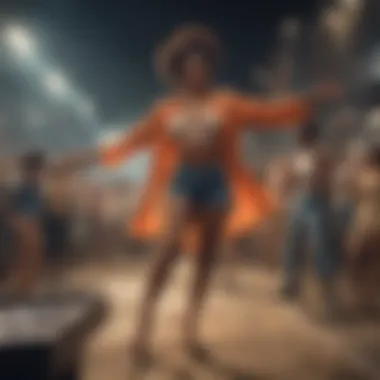The Soundtrack of a Movement: Summer of Soul


Intro
The Summer of Soul is not only a documentary that captures a pivotal moment in music history; it also offers a profound exploration of cultural narratives. The soundtrack is a rich tapestry that weaves together various genres and reflects the social backdrop of the 1960s. This guide aims to dissect the intricate layers of the soundtrack, revealing how each element contributes to the movement of the era. From the artists who graced the stage to the thematic undertones of their songs, understanding this soundtrack provides insight into the collective consciousness of a generation.
Artist Profile
Biography and Background
The artists featured in the Summer of Soul soundtrack hail from diverse backgrounds and represent a multitude of musical styles. For instance, performers like Stevie Wonder and Nina Simone have made indelible marks on the music industry.
Stevie Wonder, born Stevland Hardaway Morris, rose to fame as a child prodigy with a series of hits that fused R&B, pop, and soul. His unique sound and powerful voice embody the creative spirit of the time.
Nina Simone, known for her deep connection to civil rights, blended jazz, blues, and folk. Her experiences as a Black woman in America shaped her artistry, influencing her messages and the emotional depth of her performances.
Major Influences and Inspirations
The artists of this era drew inspiration from a plethora of sources. Traditional African rhythms, gospel music, and blues were foundational to their works. For example, the civil rights movement significantly impacted the lyrical content of many songs performed. Each artist responded to the societal upheaval around them, infusing their music with themes of struggle, resilience, and hope.
Song Analysis
Theme and Lyrics Breakdown
The songs within the Summer of Soul soundtrack often tackle important themes. Many highlight the struggles faced by the African American community. For instance, songs like "A Change Is Gonna Come" by Sam Cooke serve as potent anthems calling for social justice. The lyrics encapsulate feelings of despair yet offer a glimpse of hope for change.
Instrumentation and Composition
Instrumentation varies across tracks but typically includes traditional elements from jazz and soul. Instruments such as the piano, drums, and horns interplay to create a sound that is both rich and dynamic. The arrangements reflect the era's musical innovations, which aimed to unite audiences through rhythmic and melodic complexity.
Each performance during the festival not only showcased the individual artist's talent but also emphasized the collaborative essence of the music scene at that time.
"The soundtrack of Summer of Soul is a testament to the power of music as a catalyst for social change, reflecting both struggles for equality and the joy of community."
Intro to Summer of Soul
The significance of the Summer of Soul lies not just in its musical offerings, but also in the cultural narrative it weaves. It was a pivotal moment that showcased musical performances while encapsulating the broader social and political milieu of the 1960s. This festival took place in Harlem, New York City in 1969, amidst a vibrant backdrop marked by civil rights movements and shifting societal norms. To understand the depth of the soundtrack, one must first acknowledge its roots, not only as a collection of songs but as a reflection of collective struggles and aspirations. Through this exploration, readers can better appreciate how the soundscape of this festival interlinked with the cultural identity of the time.
The Origin of the Festival
The Harlem Cultural Festival, popularly referred to as Summer of Soul, was organized by Tony Lawrence. It aimed to celebrate African American culture and promote unity during a time rife with tension and unrest. Lawrence envisioned a space where art could serve as a conveyance for messages of hope and resistance. The festival lasted for six weekends and featured a diverse array of notable artists, including the likes of Nina Simone, Stevie Wonder, and Sly and the Family Stone.
The origins of this festival are crucial in understanding how it became a vital hub for musical expression and social dialogue. It was relatively overshadowed by its counterparts, particularly in comparison to the Woodstock festival that occurred the same summer. However, the Summer of Soul offered a distinct perspective, ensuring that voices representing African American experiences were heard and celebrated.
Overview of the Documentary
The documentary titled "Summer of Soul," directed by Ahmir "Questlove" Thompson, offers a thorough revisit to the festival. It provides a rich archival exploration of the performances and the cultural dynamics of the time. By using rare footage and personal testimonies, the film highlights the festival's importance as more than just a music event; it was a profound statement of cultural pride and resilience.
This documentary denotes a resurgence of interest in the festival, bringing attention to the artists and their performances which may have been overlooked in mainstream narratives. The intertwining of music, dance, and social commentary vividly illustrates the complex history that enveloped this event. It allows modern audiences to connect with the ethos of the 1960s, framing the soundtrack within a larger discourse on identity and activism.
"The Summer of Soul is not just a celebration of music; it is a revival of the spirit that united generations for a common purpose."
Understanding the Cultural Context
To fully appreciate the significance of the Summer of Soul soundtrack, it is essential to understand the cultural backdrop against which this music emerged. The 1960s were a period marked by social turmoil, polarizing political movements, and profound cultural shifts. This era witnessed the rise of civil rights activism, anti-war protests, and a quest for racial and social justice, themes that resonated deeply within the music of the time. Music was not merely a form of entertainment; it served as a powerful tool for expression and mobilization, reflecting the heartbeat of a generation yearning for change.
Historical Significance of the Era
The historical significance of the 1960s cannot be understated. In the United States, the fallout from World War II and the subsequent economic boom led to rapid social changes. Racial segregation and systemic inequality spurred the civil rights movement, where figures like Martin Luther King Jr. began to gain prominence. Events such as the March on Washington in 1963 and the passage of the Civil Rights Act in 1964 became pivotal moments that defined the struggle for equality.
Musically, this period generated a fusion of genres, as artists drew inspiration from gospel, blues, and folk traditions to create songs that voiced the struggles and aspirations of African Americans. The Summer of Soul festival was not just a musical gathering; it symbolized unity in the face of adversity. It harnessed the power of music to educate, inspire, and entertain, while shining a spotlight on the contributions of Black artists to the broader American culture.
Music as a Vehicle for Change
Music in the 1960s acted as a means of communication, linking various movements and communities. Songs became anthems of change, rallying people around a cause. The Summer of Soul festival showcased this phenomenon perfectly. Artists like Nina Simone and Sly and the Family Stone used their music to confront pressing social issues and inspire audiences.
The lyrics of many songs written during this time were laden with messages of hope, resistance, and empowerment. For instance, songs that addressed issues like racial injustice, poverty, and inequality were not only reflections of the societal issues at hand but also served as calls to action. This role of music as a catalyst for change highlights its importance during the civil rights movement and beyond.
"Music can change the world because it can change people." – Bono
Featured Artists and Their Impact
The artists featured in the Summer of Soul soundtrack are critical to understanding the festival's significance. Their music captured the essence of the 1960s, embodying a wide array of emotions, experiences, and cultural movements. By examining each artist and their contributions, one can appreciate how their work not only entertained but also informed social consciousness. This section highlights how these groundbreaking musicians influenced each other and the broader cultural landscape.
Stevie Wonder: A Young Prodigy
Stevie Wonder was just a teenager during the Summer of Soul festival, yet his performance made a lasting impression. At such a young age, Wonder showcased remarkable talent, both in his singing and his mastery of instruments. His song "Fingertips" became a representation of youthful exuberance and raw artistic energy.
Wonder's ability to blend various musical genres contributed to the festival's diverse atmosphere. His use of rhythm and improvisation reflected the pioneering spirit of the movement. Moreover, Wonder's music spoke to the hopes and struggles of African Americans, making him an essential figure during a pivotal time in history.
Nina Simone's Vocal Prowess
Nina Simone brought a unique blend of storytelling and emotional depth to her performances. Her powerful voice and poignant lyrics resonated with the civil rights movement. Songs like "To Be Young, Gifted and Black" became anthems for the struggle against racial injustice. Simone's activism and artistry made her a vital voice in the 1960s cultural landscape.
Her music transcended mere entertainment; it served as a powerful tool for social commentary. Simone's fearlessness in addressing difficult topics in her lyrics engaged audiences with the realities of systemic oppression. Therefore, her contributions to the Summer of Soul soundtrack reflect both personal and collective narratives.
Sly and the Family Stone: A Genre-Bending Force
Sly and the Family Stone embodied the spirit of innovation in music. Their unique sound, which fuses rock, funk, and soul, appealed to a diverse audience. This fusion broke down racial barriers during a time when segregation was rampant. Their performance at the festival showcased an electric stage presence, captivating attendees.


The band's hit "Everyday People" promoted themes of unity and acceptance, resonating deeply with the social climate of the era. The group's commitment to inclusivity and self-expression polarised them at the time. Yet, their influence remains significant in music to this day, inspiring countless artists across genres.
"The power of music can transform lives, and the Summer of Soul soundtrack served as a testament to this truth."
Their innovative approaches drive the cultural exchange of ideas, reflecting the shifting landscape of the 1960s. Thus, understanding the impact of these artists helps illustrate how music often serves as a mirror to society.
Musical Analysis of the Soundtrack
The musical analysis of the Summer of Soul soundtrack plays a crucial role in understanding both its cultural significance and its artistic merit. This section unpacks the rich tapestry of sounds that emerged from the festival, shedding light on how these elements intertwined with the social and political landscape of the time. The diversity of genres, thematic lyrics, and intricate arrangements all contribute to a greater comprehension of the music's impact during a pivotal moment in American history.
Diverse Genres Represented
The Summer of Soul soundtrack is characterized by its eclectic mix of genres, reflecting the multifaceted nature of the music scene in the 1960s. From gospel and soul to jazz and rock, each genre offers a unique lens through which to view the era's cultural dynamics. Notably, artists like Mahalia Jackson infused gospel with emotional depth, while Sly and the Family Stone introduced elements of funk that redefined contemporary music.
This genre diversity served not only as entertainment but also as a means of expression for marginalized communities. The blending of styles highlights a collective desire for change and unity. The festival provided a platform where musicians could transcend boundaries, both socially and musically.
Lyric Themes and Messages
The lyrics featured in the Summer of Soul soundtrack encapsulate the struggles and aspirations of the African American community during the 1960s. Many songs assert themes of resilience, protest, and hope. For example, Nina Simone's "Young, Gifted and Black" embodies pride in heritage and a call for recognition.
Lyrics often reflect the urgency of the Civil Rights Movement, addressing systemic inequality. Amiri Baraka’s influence resonates in many pieces, where the messages are rooted in activism and awareness. These artistic expressions provided both a soundtrack for protests and a source of empowerment for those who felt voiceless.
"Music is a weapon. It can be used to heal or to harm, to inspire or to destroy."
Instrumentation and Arrangements
The instrumentation and arrangements of the Summer of Soul tracks are noteworthy for their complexity and innovation. Musicians employed a wide array of instruments, from traditional brass and percussive elements to electric guitars and synthesizers. The interplay between vocal harmonies and instrumentation creates a rich auditory experience that engages listeners on multiple levels.
For instance, the arrangement in Stevie Wonder's performances showcases intricate harmonica solos that complement the rhythm section, adding a layer of excitement. The collective efforts of both soloists and ensembles demonstrate a robust collaborative spirit that was prevalent at the festival.
These arrangements often mirrored the emotional content of the lyrics, enhancing the overall message and leaving a lasting impression on audiences. The fusion of various musical elements contributed significantly to the soundtrack’s ability to resonate with listeners across generations.
In summary, the musical analysis of the Summer of Soul soundtrack reveals its importance as more than just a collection of songs. This evaluation helps to situate the soundtrack within a broader cultural and historical context, showcasing how music can capture the essence of social movements and ultimately define a generation.
Reception and Legacy
The reception and legacy of the Summer of Soul festival are integral to understanding its immense cultural and historical significance. This event not only showcased a rich tapestry of musical talent but also served as a powerful platform for social and political expression during a transformative era in American history. Analyzing how the festival was initially received, as well as its lasting impact, provides insight into the ways in which music intersects with movements for social justice and cultural identity.
Initial Reception of the Festival
When the Summer of Soul festival unfolded in 1969, it was met with a mixed bag of reactions. While enthusiasts and attendees embraced its vibrant atmosphere, commercial media coverage was relatively sparse. The festival, held in Harlem, featured various legendary artists and performances that were groundbreaking for the time. However, the prevailing racial tensions and societal unrest made broader public reception complicated.
In the immediate aftermath, the festival was a significant local event, enjoyed by over 300,000 participants, but it did not receive the same national spotlight as Woodstock held just weeks later. This lack of attention may have stemmed from the festival's promotion of Black culture in a moment when mainstream media was slow to acknowledge such expressions. Despite these challenges, many who experienced it described a profound sense of unity and purpose.


"The Summer of Soul was not just a concert; it was a declaration of a cultural movement that demanded recognition."
The performances were characterized by both talent and raw emotion, reflecting the realities faced by African Americans at the time. Singers like Nina Simone and groups like Sly and the Family Stone communicated messages of hope and resistance, elements that anchored the participant's experience. However, it would take decades for this festival to be recognized in historical narratives and academic discussions.
Long-term Cultural Impact
The long-term cultural impact of the Summer of Soul festival resonates across generations. As awareness of the festival grew in retrospect, it became a symbol of the intersection between music and activism. The festival's collection of music reflected not only the sounds of the 1960s but also the complexities of the civil rights movement.
Over the years, both the festival and its soundtrack have inspired a range of contemporary artists. Musicians such as Common and Alicia Keys have acknowledged the influence of the musical styles and messages that emerged during this period. The festival helped solidify genres like soul and funk while promoting an appreciation for Black artists who addressed societal issues through their art.
Moreover, the legacy of the Summer of Soul is felt in modern social justice movements. Music continues to serve as a rallying cry for those advocating for change. Today’s artists often draw on the themes presented during this festival to address current challenges facing marginalized communities.
In summary, the impact of the Summer of Soul festival stretches far beyond its immediate reception. It has evolved into a cultural touchstone, illustrating how music can inspire movements and foster a sense of community.
Connection to Contemporary Movements
The influence of the Summer of Soul soundtrack reaches far beyond its original time and setting. It provides a lens through which one can examine the significant continuities between past and present movements for social justice. This section explores how the legacy of this landmark event shapes modern music and movements, offering insights into the ways music functions as a vehicle for social change.
Influence on Modern Artists
Many contemporary artists draw inspiration from the sounds, themes, and spirit of the Summer of Soul soundtrack. This festival showcased artists who expressed common struggles, dreams, and aspirations, ultimately encouraging a new generation to vocalize their own experiences through music. For example, the integration of funk, soul, and gospel elements in tracks by artists like Anderson .Paak and Leon Bridges reflects this influence.
Modern artists often tackle social issues in their lyrics, emphasizing the importance of identity and empowerment. These artists recognize the roots laid in the music of the 1960s. The emotional resonance found in Nina Simone's and Sly and the Family Stone's performances informs their creative process, allowing today's musicians to connect with listeners on a deeper level. Tracks that deal with race, inequality, and personal experience serve to reinforce the continued significance of music in social discourse.
Music in Today’s Social Justice Movements
In contemporary society, music has become a powerful tool for activism. Inspired by the Summer of Soul, many artists utilize their platforms to address pressing social issues, similar to the way Stevie Wonder and Nina Simone did in their time. The resurgence of protest songs underscores the connection between music and social movements, highlighting important themes such as racial equality, gender rights, and economic justice.
"The rhythm of the people will always find its way back to the stage, where it echoes forever.”
Current movements like Black Lives Matter and various climate justice initiatives often rely on music to unify participants and amplify their messages. Songs that evoke collective memory and shared experiences can rally people together, providing both hope and motivation.
Overall, the Summer of Soul soundtrack serves as a vital reference point. Its rich legacy provides a framework through which musicians and activists can forge connections, ensuring that the legacy of past struggles continues to inform and inspire future generations. By understanding this historical context, we can appreciate the profound influence music has on contemporary movements.
Finale
The exploration of music’s role during the Summer of Soul reveals profound connections between sound and social movements. This conclusion synthesizes the insights from earlier sections, focusing on the enduring power of music and reflecting on the lasting impact of the festival.
The Enduring Power of Music
Music serves as a powerful catalyst for social change, and the Summer of Soul exemplifies this truth. The songs performed during the festival did not merely entertain; they communicated messages about identity, cultural pride, and resistance. The performances of artists like Nina Simone and Stevie Wonder transcended mere rhythm and melody. Instead, they acted as rallying cries for the civil rights movement, embedding themselves deep within the consciousness of a generation.
Just as the civil rights protests echoed through the streets, the melodic sounds of the festival resonated in the hearts of those who attended. These songs captured the spirit of the moment, urging individuals to stand for justice and equality. The music of Summer of Soul is, therefore, not just a historical artifact; it is a reminder of the resilience and strength inherent in collective experiences.
"In many ways, the soundtrack of the Summer of Soul personifies the struggle and the triumph of its time. It reflects the complexities of the human experience, speaking to issues that remain relevant today."
Final Thoughts on Summer of Soul
The documentary encapsulates this rich history, reminding audiences of the artistry that flourished during a time of great upheaval. As music enthusiasts, aspiring musicians, and music students reflect on this period, they recognize the profound connections between sound and social identity. Ultimately, the Summer of Soul stands as a testament to the unifying power of music, serving both as a mirror to society and a beacon for future generations.







